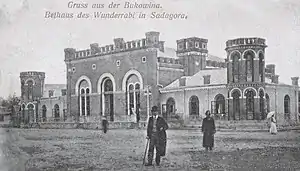Sadhora (Ukrainian: Садгора; German: Sadagora; Polish: Sadagóra; Romanian: Sadagura; Yiddish: סאדיגורא Sadigora, also Sadagura and Sadiger) is a settlement in Ukraine, now a Sadhirskyi District of Chernivtsi city, which is located 6 km from the city center. Previously, it was an independent town.
History

Sadhora was established in 1770 by a former Saxon and Polish official, Baron de:Peter Nicolaus von Gartenberg (1714-1786). Sadhora is located in Bukovina, a region which was part of the Principality of Moldavia until the 1770s when it was conquered by the Habsburg monarchy, becoming part of the Duchy of Bukovina under the Austrian Empire starting in 1849, then becoming an Austrian "crownland" from 1867 until the end of World War I, after which it was ruled by Romania for two decades (1918-1940).
During the Russo-Turkish War, 1768-1774, the commander-in-chief of the Russian army in Moldavia and Wallachia took measures to enhance the economic and monetary system in the principalities. Therefore, a mint was established in a formerly wooded area by a river, by a man with previous experience in this field, Baron Gartenberg, Slavic Sadhóra being a literal translation of the German "Gartenberg", "garden mountain." Beginning in 1771, the coins that were minted at Sadhora displayed the coats of arms of both Moldavia and Wallachia on the same side. The mint was closed down at the end of the war, in 1774.
Jewish history
Sadagóra had a significant Jewish community and it is important in the history of Hasidic Judaism. Before World War I, the Jewish population numbered over 5,000.[2]
Rabbi Yisroel Friedman, the Ruzhiner Rebbe, relocated his court to Sadagóra in 1842. In 1838 he had been accused of complicity in the death of two Jews accused of being informers and was imprisoned for two years by the Russian authorities. On his release he fled to Kishinev, then to Iaşi and other places before finally settling in Sadagóra in 1842, where he re-established his Hasidic court in all its glory.

The Ruzhiner Rebbe lived in Sadagóra for ten years, building a palatial home and a large synagogue. Tens of thousands of Hasidim frequented his court.[3] When he died at the age of 54 on 9 October 1850,[4] each of his sons moved to different towns to establish their own courts. His eldest son,[5] Rabbi Sholom Yosef Friedman, remained in Sadagóra to continue leading the court his father had founded, but died ten months later.[2] At this point, the second son[5] of the Ruzhiner Rebbe, Rabbi Avrohom Yaakov Friedman, assumed the mantle of leadership of the Sadigura Hasidim, becoming known as the first Sadigura Rebbe.[6] After his death, his second son, Rabbi Yisrael Friedman (1852-1907), succeeded him as Rebbe. He, in turn, was succeeded by his eldest son, Rabbi Aharon of Sadigura (1877-1913), and by another son, Rabbi Avrohom Yaakov Friedman, who escaped to Vienna with the outbreak of World War I in 1914 and established his court in that city for the next 24 years,[2][7] effectively putting an end to the once-flourishing Jewish community in Sadagóra . The remaining Jews of Sadagóra were decimated by the Nazis during World War II.[2] After the Anschluss of 1938, the Sadigura Rebbe procured a visa to Palestine, where he led his court in Tel Aviv until his death in 1961.[8] Today, Sadigura Hasidism is centered in Bnei Brak, Israel.
Geography
Latitude, 48.3500°, Longitude, 25.9667°, Altitude (feet), 941
References
- Leo Bruckenthal. Geschichte der Juden in der Bukowina ("History of the Jews in Bukovina"), Hugo Gold: Tel Aviv, 1962, pp. 98–105.
Notable people
- Aharon Appelfeld, writer and novelist
- Avrohom Yaakov Friedman (1820-1883), first Sadigura Rebbe
- Avrohom Yaakov Friedman (1884-1961), third Sadigura Rebbe
- Yisroel Friedman (1797-1850), Rebbe of Ruzhin
- Yitzchok Friedman (1850-1917), first Boyaner Rebbe
- Yossele Rosenblatt, chazzan
References
- ↑ William D. Craig (1971). "MOLDAVIA and WALLACHIA Principalities". Coins of the World 1750–1850. Racine, Wis. USA: Western Publishing Co. p. 51 #3.
- 1 2 3 4 Meringer, Motty (31 August 2009). "The Sadigur Chassidic Court". Tog News. Archived from the original on 2 May 2015. Retrieved 9 January 2013.
- ↑ Friedman, Yisroel. The Golden Dynasty: Ruzhin, the royal house of Chassidus. Jerusalem: The Kest-Lebovits Jewish Heritage and Roots Library, 2nd English edition, 2000, p. 15.
- ↑ Assaf, David (2002). The Regal Way: The life and times of Rabbi Israel of Ruzhin. Stanford University Press. p. 170. ISBN 0804744688.
- 1 2 Friedman, The Golden Dynasty, p. 20.
- ↑ Friedman, The Golden Dynasty, pp. 15–17.
- ↑ Friedman, The Golden Dynasty, pp. 38–39.
- ↑ Friedman, The Golden Dynasty, p. 45.
External links
- (in Romanian) Emisiuni monetare Sadagura ("Issuing of money in Sadagura"), includes images of the coins mentioned in the article.
.jpg.webp)
.jpg.webp)
